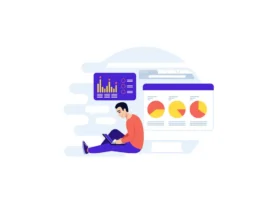The development of E-commerce has pushed many physical retailers, who offer their products in a retail format, to adapt in order to offer an optimised customer experience.
The retail sector has had to reinvent itself in recent years in order to cope with market changes and consumer expectations. Indeed, consumers are increasingly demanding in terms of shopping experience. In addition, they are rapidly becoming accustomed to the convenience of Internet consumption.
Even if we tend to oppose retail and e-commerce, the latest trends suggest that the two distribution models are getting closer. Retailers, like pure players, have a common goal: to distribute their products to as many consumers as possible.
In this article, we will introduce you to retail, with a complete guide to the different strategies and trends, while providing you with retail and E-commerce solutions to satisfy a maximum number of consumers.
Retail: Definition
Retail means the sale of products by a person (retailer) or a company directly to consumers. Sales are made in small quantities, either at a physical point of sale or directly online. The retailer is thus distinguished from a wholesaler or supplier who sells its products in larger quantities directly to professionals.
The top retailers in the UK
The ranking of these retailers is based on the turnover generated in 2022. The data is collected by Retail Sector.
1. Tesco

Tesco is a British retailer founded in 1919. It has a turnover of over £54 billion in 2022. It operates in 12 countries and has over 3,780 shops worldwide. Tesco is also active in the online market, offering click & collect and home delivery options for its customers.
2. Sainsbury’s

Sainsbury’s, Tesco’s historic competitor, is the natural second place finisher.
It is a British retailer founded in 1869. It has a turnover of over £28 billion in 2022. It operates throughout the UK, employing around 180,000 people and owning over 1,400 shops.
3. Asda

This British retailer was founded in 1949 and has been owned by Walmart since 1999. Like the two previous retailers, it is a heavyweight in the sector.
- 22 billion pounds turnover in 2021.
- 145,000 employees
- 600 shops
4. Amazon UK

A subsidiary of Amazon, Amazon UK is an online retailer founded in 1998. It will generate approximately £26 billion in sales by 2021. It offers a wide variety of products and services, ranging from books, clothing and electronics to video streaming, music and cloud computing services. It also offers fast delivery, Click & Collect and home delivery options for its customers. Amazon UK employs around 50,000 people in the country.
5. Morrisons

Like its competitors at the top of this ranking, Morrisons is a British retailer. It was founded in 1899 and is named after its founder. It has a significant market share.
- 17 billion pounds turnover in 2021.
- 120,000 employees and
- 500 retail
| Name | Turnover in 2022 | Year of creation |
| 1. Tesco | £54.76bn | 1919 |
| 2. Sainsbury’s | £28.8bn | 1869 |
| 3. Asda | £22.8bn | 1949 |
| 4. Amazon UK | £26.92bn | 1998 |
| 5. Morrisons | £17.6bn | 1899 |
What are the trends in retail?
Retail is, of course, not only made up of large-scale distribution chains. However, the sector is undergoing a major transformation. Indeed, shops, regardless of their size, need to rethink their distribution as a whole to find a balance between offline and online.
To do this, retailers are turning more to digital innovations in order to improve the customer experience. Here are 6 trends that are strongly influencing the market, especially since the health crisis of 2020/2021:
- Phygital
- Omnichannel / cross-channel
- Increased proximity
- Transparency and authenticity
- Artificial intelligence
- Voice commerce (V-commerce)
Phygital
The digitalisation of commerce is pushing physical retailers to adopt new distribution methods, adapted to the new habits of consumers. This leads directly to the creation of a complementarity between physical retail and online distribution.
This means that retailers need to be aware of the importance of digital in today’s retail model. This is especially true as consumers are increasingly adopting web-to-store behaviour. This means that many potential buyers are searching the internet before buying in-store, especially to get information about the product they want. According to Google, 91% of consumers engage in this behaviour.
For this reason, the concept of the phygital store was born. Phygital is a contraction of the words “physical” and “digital”, representing the objective of combining the advantages of retail with the freedom offered by e-commerce.
For the retailer, the aim is to place the customer at the centre of his strategy in order to put him in the spotlight and to deploy communication and distribution channels around him. The customer journey should then be more fluid, passing naturally from E-commerce to the physical point of sale. To implement this strategy, many devices can be deployed such as mobile payment, click and collect, touch terminals, chatbots, etc.
Some major brands are particularly interested in phygital to increase their sales. This is notably the case for Tommy Hilfiger in 2022, which is presenting its ready-to-wear collection during American Fashion Week both physically and digitally. In addition to creating an event, this allows its products to be presented to a larger number of people simultaneously.
Omnichannel and cross-channel, what are the differences for retail?
Omnichannel takes up the logic presented above. The customer is put at the centre of the strategy and the channels are merged to offer a rich, personalised and fun experience, both online and in person.
The customer and the retailer are then able to leverage the functionality and potential of all these channels to deliver a unique experience. Connected points of sale with kiosks, sales assistants equipped with touch-sensitive tablets, etc. are examples of the exploitation of omnichannel.
Cross-channel allows the generation of rich customer journeys, involving several channels in succession. The objective is to create bridges so that these different channels become complementary. Cross-channel therefore makes it possible to move from one (physical) channel to another (virtual), and vice versa.
Once again, click & collect is an example of a cross-channel strategy. The consumer buys a product on the website and then collects it from a physical point of sale. This allows sales staff to obtain more information about the customer’s purchasing path. This knowledge can then be used to personalise offers, for example through the communication of personalised discount coupons.
Cross-channel is a strategy particularly used by click & mortar shops, which have a strong presence online as well as in physical stores.
Strengthening proximity
Consumers are increasingly inclined to support local businesses and to take advantage of the opportunities that this offers. Indeed, proximity makes it easier to create links with retailers. The latter will then be better able to make personalised offers and apply personalised communication.
The health crisis and ecological awareness have changed consumer behaviour. They want to consume in a more responsible way, and to find a link with the sellers who advise them.
This proximity is reflected in the multiplication of small physical sales outlets, closer to where people live (in the city centre, for example). Local consumption is an added value, especially today. The IKEA brand, known for its huge sales outlets, offers city centre shops in London, adapted to the size of local shops.
Hyper-personalisation is a strategy that pays off, as it provides a sense of trust and understanding to the consumer. More and more large retailers are adopting this strategy, especially with the aim of building consumer loyalty. To achieve this, the objective is to offer a memorable shopping experience to customers, who are looking for varied experiences adapted to their tastes, desires, needs, etc.
Nike has created an innovative experience in its physical store on the Champs-Elysées. The brand has used augmented reality technology to give consumers the opportunity to personalise their shoe models directly in the shop.
Transparency and authenticity
The ecological awareness of consumers is accompanied by an awareness of their purchases in general. Especially among the younger generation of shoppers, transparency and authenticity of brands is important. Consumers now prefer “local”, environmentally and socially responsible products from brands that respect their customers.
These buyers are therefore increasingly turning to transparent brands, highlighting their CSR policy, but without falling into greenwashing, which is badly perceived.
Customers want to adhere to a brand and its values. Ethics are becoming more and more important. Consumers no longer hesitate to pay more for a product that corresponds to their values. This is why a large number of companies have chosen to focus on transparency in their communication.
Barcodes are a good way to check certain information about a product. Bar codes do provide information about the origin of a product.
Brands that position themselves on transparency and authenticity tend to stand out from the crowd thanks to the creation of a stronger link with their customers. This allows them to create a real community around the brand and its products, its messages, etc. This promise of quality and transparency is gradually becoming a market standard. This is one reason why consumers have more confidence in small traders (especially local traders) and craftsmen.
Another trend that is representative of this search for ethics and responsibility among consumers is the explosion of the second-hand market, such as Vinted. This growth is partly explained by the desire to save money, but also to limit consumption in order to protect the environment.
Artificial Intelligence
Artificial intelligence and its possibilities are changing the world. One sector is particularly affected by this evolution: retail. Artificial intelligence offers process optimisation in many aspects of a retail chain, from the warehouse (especially with the development of Industry 4.0) to the final point of sale.
Many applications are possible: predictive analysis, order preparation and automation, the use of chatbots in customer relations, marketing automation, etc.
The idea is to use AI to save time. It is also an opportunity to get to know visitors better, the aim being to personalise the customer experience. To this end, Amazon has launched a test of fully autonomous and automated retailing with the concept called Amazon Go, particularly in Seattle.
Among consumers, artificial intelligence is used extensively in virtual voice assistants, such as Siri on iOS systems.
Are you intrigued by the incredible capabilities of AI but also worried about its future outcomes? If so, you must read the “The current and future impact of artificial intelligence on businesses” article.
Voice commerce
V-commerce is becoming increasingly popular with consumers. According to a study conducted by Havas and Paris Retail Week, 57% of French consumers rely on voice assistants to facilitate their shopping. These virtual assistants are becoming increasingly intelligent, offering a wide range of features to make life easier for consumers and retailers.
This rise in the use of voice is shaking up commerce and forcing companies to adapt by reviewing their strategy. This particularly concerns organic referencing, as well as customer relations. This is why major retailers such as Tesco and Asda have launched their own voice assistants. This makes it possible to create a shopping list easily.
What retail strategy should be implemented?
In order to balance the offline and online distribution models, companies have adopted new strategies. To achieve this, shops are increasingly relying on digital innovations and features to reinvent the customer experience.
- The digital catalogue
- The supply chain
- Data
- Customer experience
- Social networks
The digital catalogue
The catalogue is a very effective marketing tool. Traditionally, this term brings to mind the early days of distance selling. However, nowadays, this tool has been overtaken by other digital levers such as emails, SEA, social networks, …, which are less expensive.
The catalogue has therefore adapted to become digital, and no longer only available for retail. Indeed, many consumers start their purchasing journey on the Internet.
This cross-channel strategy reduces distribution costs and makes it easier to engage consumers. The targeting is indeed wider and the catalogue can be personalised. In addition, digital allows for data measurement and analysis, which provides a wealth of information, including whether the strategy is generating shop visits.
This strategy, combined with accurate monitoring and optimisation, can be a very effective drive-to-store lever.
Optimise the supply chain
As mentioned earlier, omnichannel is becoming increasingly important in the retail sector. This is why many physical retailers are taking a closer look at the supply chain and its optimisation possibilities.
In order to improve the customer experience, optimising logistics and omnichannel distribution is becoming a key issue. In a logic of personalisation of the customer experience, companies want to offer more and more possibilities to customers, such as the choice of the place of delivery, the delivery method, …
To offer these services and save time, the physical point of sale must rethink its supply chain and last mile delivery in particular. The warehouse becomes a central element as salespeople look beyond the shop. Brands need to be able to process orders, while managing replenishment and having full, real-time visibility of stock from any part of the distribution network.
Automated supply chain processes are increasingly common. There are robots that process and prepare orders, and artificial intelligence programmes that use the data collected to optimise stocks.
The use of data
Data is the new black gold, very valuable for retailers wishing to optimise their processes and user experience, in particular. It is coveted because it provides important and relevant information about consumers.
According to IBM, 62% of retailers say that using Big Data techniques gives them a competitive advantage. This has been well understood by the Amazon marketplace. The e-commerce giant’s teams have been pioneers in the use of data. In particular, this has enabled them to gain a competitive advantage with the personalised suggestions included in the purchase path.
Customer knowledge is a fundamental step in the deployment of an effective marketing strategy. This is where the data collected comes in. It can be used to send the right messages to the right people at the right time via the right channel. The challenge is to be able to unify the data collected in retail as well as online, which will help measure the impact of advertising campaigns at the point of sale.
All this data, properly processed, opens the way to predictive commerce. This offers the possibility to influence a consumer’s buying decision at any stage of the buying process. It is also possible to create a relationship of trust with the customer, optimising loyalty and interactions.
To be able to collect this data and apply the personalisation of the offer at the point of sale, a multitude of solutions currently exist. For example, it is possible to offer WiFi access. This allows smartphones or connected shopping carts to be located, which helps to analyse the time spent by consumers in a particular area of the shop.
Create a more immersive shopping experience
Vendors are innovating to attract consumers to physical retail outlets, which has led them to start digitalising retail in order to improve the customer experience and compete with e-commerce.
Customers are not just buying products, they are looking for a complete and immersive experience. This means giving consumers a reason to come to the shop. The store becomes a place to demonstrate the value of your product.
The aim is to provide a different experience, encouraging the customer to buy. The retail experience must be immersive, original and adapted to the consumer’s expectations. This can be done through the implementation of a storytelling around the brand, its products, its leaders. Emotion is a central element of this experience.
To improve the customer experience, many innovations are appearing in the retail sector. These include cashless payments, connected shopping carts, touch screens and tablets at the point of sale, and augmented reality.
Once again, the Nike brand has confirmed that it has taken the digital turn by offering immersive experiences in its physical outlets. The company has taken advantage of the particularly artistic and cultural setting of the Hongdae district in Seoul to offer a unique experience. In this Nike Style shop, customers can take advantage of product experts, studios for content creation and community spaces for exchange.
Presence on social networks
As they evolve, social networks are becoming an increasingly important part of consumers’ and sellers’ lives, especially in terms of communication. Retail is no exception to this rule, getting the opportunity to leverage the audience in order to retain customers, engage them, or even acquire new ones.
In fact, according to Forbes, 78% of sellers using these social platforms are more successful than those who choose not to. A presence on social networks allows for greater proximity with consumers.
Today, everything is shared on social networks, which embellish every content. Thus, offering a unique, original and adapted shopping experience becomes important. The qualitative experience is indeed more easily shared on social networks. This is called User Generated Content (UGC). This promotion, passive and free of charge, is carried out through consumers’ publications.
You can read more about the impacts of user-generated content in the “Decoding the Meaning of User Generated Content (UGC)” article.
In addition, social networks are becoming a real distribution channel for brands. More and more of these platforms are developing integrated shopping features. For example, Instagram has set up Instagram Shipping, allowing companies to place links directly on their photos, directing them to their online shop for example.
Pinterest, for its part, offers something similar with the Shop the Look feature, as does Snapchat, which is multiplying its updates towards e-commerce sales.
Retail solutions
Numerous technological advances have led to a multiplication of sales channels (e-commerce, drive, m-commerce etc.). It is in this omnichannel context where the customer experience plays a key role that retail must begin its transformation.
The challenge for retail is to bring together all these channels to offer a unique, personalised and seamless experience. Here is a list of several retail solutions that can help you achieve this transformation:
- Cegid
- SES-imagotag
- Retail Pro
- Comarch
- Visiativ Retail
- Zebra
- Oracle Retail
- Manhattan Associates
- Octave
- Cegid: the complete retail solution

Cegid is a SaaS management solution for professionals in the fields of accounting, finance and taxation, payroll and human resources and retail. The solution helps companies and public organisations in their digitalisation.
Cegid works with more than 1,000 retail owners in over 75 countries and offers in its solution :
- Integration of new omnichannel consumption modes to improve the customer experience;
- Optimisation of stocks and supply points, to improve the management of goods flows.
- SES-imagotag: electronic labels for retail

SES-imagotag is a solution dedicated to the retail industry, present in 62 countries and more than 17,000 shops. This solution provides electronic labels.
With this system, you can automate the management of your retail products (dynamic pricing, stock management and inventory), but also offer marketing services that do not require contact such as mobile self-scan, geolocation or customer identification and targeted offers.
- Retail Pro: cash register software for retailers

Retail Pro is a retail cash register and stock management software, which is installed in over 90 countries and used by over 159,000 users. This solution allows you to :
- Manage customer relations, you can analyse consumer behaviour and launch relevant promotional actions to build customer loyalty.
- Stock management, definition of a level according to the sales performance of each product and of upper and lower thresholds to have automatic proposals for restocking.
- Comarch: managing retail and e-commerce channels

Comarch Retail is an integrated solution that allows you to manage all your sales channels from a single tool. This retail solution includes more than 60,000 customers in Europe and worldwide.
The solution offers a set of software solutions to manage :
- Omnichannel sales, to manage several points of sale from a single tool.
- Customer experience, managing loyalty programs, customer relations and marketing support
- Supply-chain, managing merchandise purchases, point-of-sale supply processes and logistics processes
- Visiativ Retail: supporting digital transformation

Visiativ Retail offers retailers comprehensive support for their digital transformation, both in France and abroad. The Visiativ group has over 30 years of experience in digital transformation and more than 18,000 customers.
The solution offers to manage :
- Sales area: 3D merchandising and 3D packaging
- Sales force: btob e-commerce website, mobile order-taking application, CRM field sales force
- Reseller network: stock management, animation and provision of order taking tools
- Support functions such as the supplier portal, quality management, employee platforms
- Zebra: Retail Visibility

Zebra’s retail and distribution solutions are designed to provide retailers with complete visibility into their shop operations. Zebra currently has more than 10,000 partners in 100 countries.
What the solution offers:
- Optimal management of customer orders, streamlining operations, stock removal and receipt
- Improve in-store efficiency
- Enhance the shopping experience with analytical tools
- Business intelligence with strategic data
- Oracle Retail: the cloud solution

Oracle Retail is a cross-channel solution for retailers. Oracle Retail’s cloud solutions enable retailers to better anticipate customer demand and simplify operations.
Oracle’s retail software enables you to:
- Orchestrate digital engagement and consumer acquisition
- Adapt manufacturing to the digital age
- Improve the cross-channel experience
- Maximise logistics performance
- Manhattan Associates: optimising your supply chain

Manhattan Associates is a retail solution that gives you complete visibility of your supply chain to improve your operational performance. This solution manages logistics activities, omni-channel activities and warehousing. Manhattan Associates retail software is used by 40% of retailers.
The functionalities offered are :
- Optimisation of goods receipt
- Improved warehousing and order picking
- Acceleration of data entry and information flow with voice recognition
- Improved management of products and resources in your warehouse
- Octave: omnichannel retail

Octave is an omnichannel commerce solution for retailers, with 20 years of experience in the field. Their goal is to help retailers and shop networks in their digital transformation.
Octave offers retailers :
- Provide a seamless customer journey, across different channels or touch points
- A mobility solution to increase the sales performance of in-store salespeople.
- To have a precise and real time vision of all logistic flows and to optimize stock levels
Retail FAQ
What is retail?
Retail means that a company or person (called a retailer) sells its products in the state in which they were purchased, directly to consumers. Sales are made in small quantities in a shop or online. The retailer thus differs from a wholesaler or supplier who sells his products to another company.
What is new retail?
A concept developed by Alibaba. It refers to the new practices of pure players and brick and mortars who want to take advantage of phygital and omnichannel strategies
How to activate your omnichannel strategy?
To activate your omnichannel strategy, you need to use all commercial and conversational channels as if they were one, to offer a seamless customer experience
Image credit: Kit8





